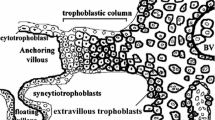Abstract
It is thought that preeclampsia results from a shallow invasion of the extravillous trophoblast into the decidua and maternal vessels, which in turn leads to hypoxia and uteroplacental insufficiency. Here, the authors focus on the expression of the proangiogenic secreted molecules CYR61 (CCN1) and NOV (CCN3) in human placentae during normal pregnancy compared with preeclamptic placentae. CYR61 and NOV are strongly expressed in endothelial cells as well as in the extravillous trophoblast, with increasing levels during placental development. Interestingly, the authors found significantly decreased levels in early preeclamptic placentae compared with matched controls. Whereas both CYR61 and NOV proteins are present at constant high levels in the sera of nonpregnant and pregnant women, in the sera of patients with early-onset preeclampsia, levels were significantly reduced. The authors suggest that the reduction of both CCN molecules in preeclampsia could be 1 reason underlying the failure of uterine vascular remodeling. Moreover, their low maternal serum levels could serve as biomarkers for early diagnosis of this disease.
Similar content being viewed by others
References
Myatt L. Role of placenta in preeclampsia. Endocrine. 2002;19(1):103–111.
Bdolah Y, Karumanchi SA, Sachs BP Recent advances in understanding of preeclampsia. Croat Med J.2005;46(5):728–736.
Sibai B, Dekker G, Kupferminc M. Pre-eclampsia. Lancet. 2005;365:785–799.
Redman CW, Sargent IL Latest advances in understanding preeclampsia. Science. 2005;308(5728):1592–1594.
Schmidt M, Gellhaus A, Kasimir-Bauer S, et al. Angiogenic factors during pregnancy: indicators of preeclampsia. Geburtshilfe und Frauenheilkunde. 2007;67:217–227.
Zhou Y, Damsky CH, Chiu K, et al. Preeclampsia is associated with abnormal expression of adhesion molecules by invasive cytotrophoblasts. J Clin Invest. 1993;91(3):950–960.
Lim KH, Zhou Y, Janatpour M, et al. Human cytotrophoblast differentiation/invasion is abnormal in pre-eclampsia. Am J Pathol. 1997;151(6):1809–1818.
Zhou Y, McMaster M, Woo K, et al. Vascular endothelial growth factor ligands and receptors that regulate human cytotrophoblast survival are dysregulated in severe preeclampsia and hemolysis, elevated liver enzymes, and low platelets syndrome. Am J Pathol. 2002;160(4):1405–1423.
Maynard SE, Min JY, Merchan J, et al. Excess placental soluble fms-like tyrosine kinase 1 (sFlt1) may contribute to endothelial dysfunction, hypertension, and proteinuria in preeclampsia. J Clin Invest. 2003;111(5):649–658.
Venkatesha S, Toporsian M, Lam C, et al. Soluble endoglin contributes to the pathogenesis of preeclampsia. Nat Med. 2006; 12(6):642–649.
Mo FE, Muntean AG, Chen CC, et al. CYR61 (CCN1) is essential for placental development and vascular integrity. Mol Cell Biol. 2002;22(24):8709–8720.
Gellhaus A, Schmidt M, Dunk C, et al. Decreased expression of the angiogenic regulators CYR61 (CCN1) and NOV (CCN3) in human placenta is associated with pre-eclampsia. Mol Hum Reprod. 2006;12(6):389–399.
Rachal AW, Brigstock DR Structural and functional properties of CCN proteins. Vitam Horm. 2005;70:69–103.
Kubota S, Takigawa M. CCN family proteins and angiogenesis: from embryo to adulthood. Angiogenesis. 2007;10(1):1–11.
Leu SJ, Lam SC, Lau LF Pro-angiogenic activities of CYR61 (CCN1) mediated through integrins αvβ3 and α6β1 in human umbilical vein endothelial cells. J Biol Chem. 2002; 277(48):46248–46255.
Lin CG, Leu SJ, Chen N, et al. CCN3 (NOV) is a novel angiogenic regulator of the CCN protein family. J Biol Chem. 2003;278(26):24200–24208.
Benirschke K, Kaufmann P, eds. Pathology of the Human Placenta. 4th ed. New York, NY: Springer-Verlag; 2000.
Roberts JM, Redman CW Pre-eclampsia: more than pregnancy-induced hypertension. Lancet. 1993;341(8858):1447–1451.
Gellhaus A, Dong X, Propson S, et al. Connexin43 interacts with NOV: a possible mechanism for negative regulation of cell growth in choriocarcinoma cells. J Biol Chem. 2004;279(35): 36931–36942.
Chevalier G, Yeger H, Martinerie C, et al. novH: differential expression in developing kidney and Wilm’s tumors. Am J Pathol. 1998; 152(6):1563–1575.
Schutze N, Kunzi-Rapp K, Wagemanns R, et al. Expression, purification, and functional testing of recombinant CYR61/CCN1. Protein Expr Purif. 2005;42(1):219–225.
Author information
Authors and Affiliations
Corresponding author
Additional information
Contract grant sponsor: German Research Foundation (DFG), grants Wi 774/21-2 and Wi 774/22-1.We thank Eva Kusch, Georgia Rauter, Gabriele Sehn, Gisela Koestner, and Dr Ljiljana Petkovic for excellent technical assistance. We are also indebted to B. Perbal and N. Schuetze for providing us with NOV and CYR61 antibodies.
Rights and permissions
About this article
Cite this article
Gellhaus, A., Schmidt, M., Dunk, C. et al. The Circulating Proangiogenic Factors CYR61 (CCN1) and NOV (CCN3) Are Significantly Decreased in Placentae and Sera of Preeclamptic Patients. Reprod. Sci. 14 (Suppl 8), 46–52 (2007). https://doi.org/10.1177/1933719107309816
Published:
Issue Date:
DOI: https://doi.org/10.1177/1933719107309816




